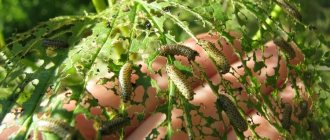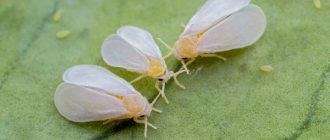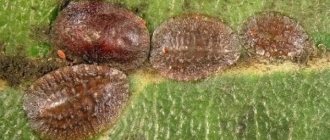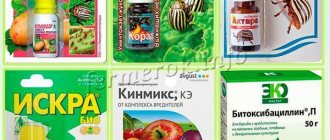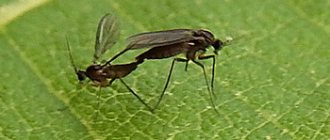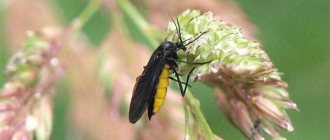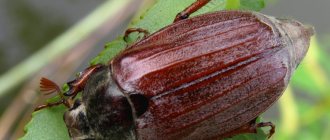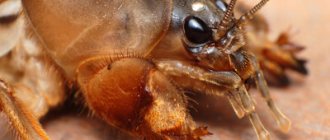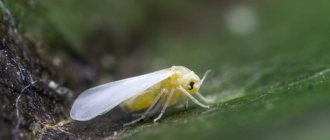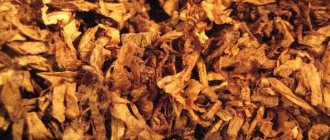roses
Controlling pests that cause rose diseases is very important because... If protective measures are not taken, the plant affected by pests often dies.
Timely and correct implementation of protective measures forms the basis of preventive protection of roses.
Advice: When starting preventive measures against diseases and pests, it is necessary to use protective equipment against pesticides - use respirators and rubber gloves. After finishing treatment, wash your hands and face thoroughly with soap and water.
Spider mite
It is active in dry, hot summers, when the temperature remains stable within +29 - +31 °C. The number of pests increases instantly, since the colony is replenished with new individuals every 14 days. Spider mites suck the juices of the leaves. Spots and bumps appear on damaged plates. The leaves curl, darken, and fall off.
When a flower garden is significantly infested, small beetles eat the whole roses - leaves, stems, developing buds, flowers. A characteristic sign of the presence of a pest is the presence of cobwebs. The bugs themselves are miniature in size - up to 2 mm, white, yellow, green, red. If you notice cobwebs and white bugs on a rose, you need to act immediately.
Bee leafcutter
Parasitizes in late June, early June. Damages leaves. A clear sign of leaf cutter sabotage is the presence of regularly shaped holes on the plate. The flowers remain untouched. The insect uses the pieces as building material.
A bee builds a nest in the immediate vicinity. Construction requires about 1,000 circles of different diameters. The bee carefully folds them and later glues them together with a special substance. To cut out the desired shape, the insect sits on a rose leaf, clings with its jaws, and spins around itself. Takes the material and flies away.
On a note!
The insect does not cause any particular harm to roses, but it significantly spoils the presentation. The likelihood of developing fungal diseases increases slightly.
Bronzovka
A large beetle with an attractive appearance. The bronze body size reaches 15 mm. The dense shell shimmers in the sun with a copper sheen. Shows activity in June and July, especially loves white and yellow roses. The beetle feeds on leaves. The bronze beetle is also popularly called the Maybug or Khrushchev.
Rose pests
The larvae are large, white caterpillars with long legs and a brown head. They live in the soil and feed on the root system of plants. The larvae weaken the plant and reduce disease resistance. If several pests are parasitizing at once, the plant may die. The May beetle on roses is not a common occurrence, but it is dangerous for a flower garden.
Rose leaf roller
If some rose leaves are curled into a tube, while others are gnawed, it means that a rose leaf roller (also known as a golden leaf roller) has settled on the plant. This pest is not a gourmet. He is not averse to eating almost all deciduous trees, fruit, berry and ornamental shrubs, as well as herbaceous plants.
The roseate leaf roller is a dark brown butterfly whose caterpillars live in folded leaves. In April-May they are reborn, first feed together, skeletonizing one of the leaves, then crawl to the tops of the shoots, gnaw out buds and buds, after which they move on to the flowers, destroying the stamens, pistils and petals.
Older caterpillars roll leaves into tubes or balls, damage ovaries and fruits, gnawing irregularly shaped holes in the pulp. After 30-40 days, the caterpillars pupate in folded leaves.
Control and prevention measures:
|
Aphid
The most common pest. Only a cold, rainy summer can save flowers. In hot weather, aphids reproduce rapidly, with about 20 generations replacing each season. Small green bugs on roses, no more than 2 mm in size, live on the underside of the leaf. When massively infected, crops stick to the stems and penetrate into the buds and blossoming flowers.
Green insects feed on sap. There is no significant harm from one individual, but aphids live in numerous colonies, so they can destroy a plant in a few weeks. The female lays eggs daily on the leaves of roses. After a couple of days, larvae appear and make passages in the leaves.
On a note!
Signs of roses being affected by aphids are curled, yellowed, blackened leaves, slower plant growth, and falling buds. When examining the flower, a colony of beetles is discovered. Emergency measures on the part of humans or a sharp cold snap can save roses.
Pests suck out the juices, reducing the resistance of roses to diseases. Infection and fungi penetrate into damaged platinum. This subsequently leads to the death of the culture.
Insect damage to rose bushes
During the period of active growth, roses are very vulnerable and require additional protection measures, because their newly formed buds and first leaves are a source of food for pests and their larvae.
Many gardeners cannot immediately determine who is eating rose leaves. The danger comes from both aphids and gnawing parasites: caterpillars, beetles, sawflies (especially their larvae). Due to the reduction in size and damage to surfaces, the plant slows down in growth, the volume and duration of flowering decreases. Gnawing pests are capable of the following:
- gnawing the pulp of leaves around the veins in the form of holes, while the veins remain intact;
- gnawing the edges of the sheet (usually curly);
- making passages through the leaf body (mining) and plant stems;
- eating buds and petals from the outer edge;
- eating stamens and pistils.
The most common sucking insects that harm rose bushes are mites, aphids, scale insects and cicadas (especially rose whiteflies). The above pests can appear in both protected and open ground.
Insect damage to rose bushes
Weevil
Black beetles on roses with long noses are weevils. Large pests with a massive body - up to 1 cm. The shell is hard, convex, there are no wings. The beetles only crawl, hiding during the day in a secluded place: under lumps of earth, leaves, on neighboring trees. They are active at night. They eat leaves of all types of roses and rose hips.
Rose pests
The larvae cause more damage to flowers. Large legless caterpillars are white. They live in the soil and feed on the roots of roses. Mass infection quickly leads to the death of the plant. The presence of parasites can be suspected by the weak growth of roses and sluggish flowering.
On a note!
Flowers growing in the shade of trees are especially affected by weevils.
Cicadas
Small bugs of white, yellow color, no more than 3.5 mm in size. Adults do not feed; the larvae are a real pest of rose bushes. Nymphs are bugs 1-2 mm in size. They live on the lower part of the leaves, hiding from the sun's rays. They feed on plant juices. Very mobile, quickly run away and hide.
Dark spots remain in places of damage, white formations are visible under the leaves - skins after molting nymphs. Roses growing in warm places protected from the wind suffer from an invasion of beetles.
Beetle eggs overwinter on shoots at the base of the buds. In spring, as temperatures rise, they begin to develop. The larvae appear at the moment the buds open, so the sabotage begins already in early May. If appropriate measures are not taken, the rose may never bloom.
Slobbery Penny
The insect received its second name - omnivorous leafhopper - because in the process of its life it secretes foam, under which it hides. Lives in the axils of leaves. The insect is mobile, its color is grayish-yellow. If you shake a rose branch, the larva jumps out of the foam and hides.
To combat these rose pests, aqueous solutions of insecticides should be used. They should spray the bushes, as well as the area where they grow, 2-3 times, taking a break between spraying of 10-12 days.
Thrips
Small green or light yellow bugs. Body size up to 1 mm. Pests are noticeable due to their large numbers - they live in colonies. They feed on juices and damage leaves, shoots, and buds. Larvae, nymphs, and adult beetles parasitize.
Red specks appear on damaged buds, and dark gray spots appear on leaves. The picture resembles damage from a spider mite, but the web is missing. Roses quickly fade or do not bloom at all. The leaves curl and fall off. The plant weakens, gets sick, and dies if there is a massive infection.
On a note!
The beetles overwinter in the top layer of soil under fallen leaves. In the spring they initially feed on weeds, then move to roses. Flowers growing in a dry place suffer the most - near the walls of the house, in flower beds on the sunny side.
Rose pests
Preventive measures
Pests and diseases of roses can cause a lot of trouble. If preventative spraying is required to combat various diseases, then in order to prevent insect invasion, additional measures must be taken:
- Treatment of roses in the spring against diseases and pests is carried out using a solution of copper oxychloride (0.4%).
- Burn all cut shoots and pulled out weeds - pests may remain there.
- Remove all leaves from the plant before wintering so that insect eggs do not remain on the bush.
- In the fall, dig up the soil under your rose bushes so that the larvae and eggs located underground will freeze during winter frosts.
- You can also treat the plant with copper sulfate in the fall.
Description and treatment of rose diseases
Massive damage to leaves disrupts metabolic processes, weakens the immune system, and makes the plant susceptible to various diseases. Microorganisms accumulate in damaged areas, causing decay and other pathological processes. All diseases of roses are divided into infectious, non-infectious or fungal. The latter are provoked by insects and their larvae.
On a note!
Due to metabolic disorders, the amount of useful minerals decreases. A lack of manganese, iron, potassium, nitrogen, phosphorus, magnesium, and manganese leads to yellowing, dying of leaves, and poor formation of buds. Treatment is carried out with mineral fertilizers, which restore the necessary balance.
Fungal diseases caused by pests - powdery mildew, leaf spot, downy mildew, rust, botrytis, bacterial cancer. To save the plant from death, damaged leaves are torn off and burned. The rose is sprayed with fungicides. Effective drugs Ridomil-Gold, Quadris, Skor, Fundazol, Strobi, Profit.
Rose Pest Control
The greatest harm to flowers is caused by small green bugs of various types - aphids, mites, thrips, etc. You can fight rose pests with folk remedies and professional chemicals. The first method is environmentally friendly, but less effective, the second is effective, but beneficial insects may die. The choice of methods and means is an individual decision.
Chemical control of beetles on roses
Treatment is carried out early in the morning or in the evening in dry, calm weather. Prepare the solution immediately before use. The concentrate is dissolved in the required amount of water, mixed thoroughly, and poured into a garden spray bottle or spray bottle.
Preparations against pests
You can get rid of green beetles and other pests in half an hour. The maximum effect lasts 2 hours. After which the drug remains to protect the plant from re-infection for another 20 days. If necessary, repeat the procedure.
The following drugs will help fight green beetles on roses, mites, and other pests:
- Confidor;
- Commander;
- Tanrek;
- Spark;
- Bison;
- Aktara;
- Aktellik;
- Fufanon;
- Lightning;
- Alatar.
On a note!
To combat soil pests and insect larvae, Pochin and Zemlin are used.
Chemicals penetrate the body of pests through the contact-intestinal route. Most of the beetles and caterpillars die in the process of spraying crops, the rest - while feeding.
Chemical-free processing
What to do if green insects appear on the rose, there is no desire to use insecticides - use folk remedies. You will have to spray the flowers twice a week until the beetles, caterpillars, and other insects disappear completely.
- Mix baking soda and salt in equal proportions. Dilute with water, add laundry or tar soap. Spray roses against beetles, paying special attention to the inside of the leaves.
- Mix ground spices - black pepper, red pepper, mustard, cumin, coriander. Fill with soapy water.
- Tobacco dust and ash are combined in equal proportions. Add soap and water. The ash burns the legs and abdomen, causing the insects to crawl away. If ingested during feeding, it provokes muscle spasms. In 50% of cases, this ends in death for beetles.
- Pour water over the onion skins, place on the stove, bring to a boil, and cook for 5 minutes. Let it brew for at least an hour. Add laundry soap. Used for watering the soil and spraying roses.
- Pests cannot tolerate the smell of pine needles. There are several options. Fresh branches of pine and spruce are placed in the flowerbed. Essential oil is added to the water and the flowers are sprayed. In the latter option, you need to spray the plant every other day.
- If the green insects on rose buds are aphids, you can get rid of them with whey. Pests cannot tolerate sour smell or taste. There is no need to add soap, since the fermented milk product sticks well to the leaves.
Folk remedies for pest control
On a note!
To prevent beetle infestation, you need to dig up the soil in the flowerbed twice a year, loosen it as the flowers grow, use fertilizers, and water the flowers in dry weather.
Preparation of solutions for spraying
Amateur flower growers do not always succeed in using a copper-soap solution and a lime-sulfur decoction. To prepare the drug efficiently, carefully follow the following procedure.
For a copper-soap solution, use only warm, soft water, preferably rainwater. If it is not available, add 5 g of soda ash or 2 g of dry mustard per 10 liters of water to soften the water. The solution should not be stored for more than 5 hours - it quickly deteriorates. The solution is prepared at the time of use in a wooden or enamel container.
300 g of liquid green soap are dissolved in nine liters of hot (50-60 °C) water; in the absence of it, 72% laundry soap is used. Then 30 g of copper sulfate is dissolved in 1 liter of hot water.
Rose. © Kyle Luker
When hot, pour the copper sulfate solution into a soapy stream in a thin stream. The place where the solutions come into contact is immediately quickly shaken or the liquid is stirred with a wooden stick. The solution turns blue. Before spraying, the drug is cooled to 20-25 ° C. If flakes fall out of the liquid, the solution cannot be used.
Lime-sulfur decoction is prepared as follows. For 17 liters of water, take 2 liters of ground sulfur and 1 liter of good quality quicklime (or 1.5 liters of slaked lime). Lime is slaked in a small amount of water, without bringing it to a violent boil. When the lime heats up, sulfur is added to it and, stirring thoroughly, the rest of the water is added. The mixture is boiled over a fire for about 50 minutes from the moment it boils, until it acquires a cherry-red color.
During boiling, add water to the original volume. Stop adding 15 minutes before the end of cooking. The finished broth is cooled, settled and filtered through a canvas into a glass, earthenware or enamel container. The strength of the decoction is determined with a hydrometer. Typically its density is 1.152-1.162 g/cm3 (10-20° according to Baume).
To spray plants, take 180-220 g of ready-made decoction (concentrate) per 10 liters of water. Two or three days before the start of treatment, do a test spraying of one or two rose bushes. If there are no burns on the plants, the solution can be used for spraying. If burns appear on the bushes, lime should be added to the solution. Store the decoction in a well-sealed container in a cool, dark place.
To prepare 10 liters of 1% Bordeaux mixture, you need to take 100 g of copper sulfate and 100 g of quicklime or 150 g of slaked lime. In one glass, clay, enamel or wooden container, lime is slaked or diluted (lime milk is obtained), in another - copper sulfate is diluted. Then, slowly, in a thin stream with rapid stirring, pour the copper sulfate solution into the lime milk solution. The resulting mixture is called Bordeaux mixture.
You can determine its suitability for processing as follows: a knife or nail, cleaned of dirt and rust until it shines, is dipped into the prepared solution. If an iron object removed from the solution becomes coated with copper, then lime must be added to the Bordeaux mixture until the plaque stops forming. To prepare 3% Bordeaux mixture, the amount of quicklime is increased accordingly to 300 g, copper sulfate - also to 300 g.
Rose. © Raul654
Herbal remedies for rose pests
If you don’t want to use chemicals, and folk remedies are ineffective, you can use herbal remedies. Natural insecticides do not act immediately, as the toxic substance accumulates in the body of insects. The result is noticeable a week after processing the flowers. Spraying is carried out every 7 days until the beetles completely disappear. Allowed to be combined with fertilizers.
- Fitoverm. The biological product operates on the basis of aversectin C. It is sold in ampoules. Acts by contact-intestinal route. Begins to act within 24 hours. Protects the plant for up to 15 days, is resistant to sunlight, but effectiveness decreases in rainy weather.
- Spark bio. A natural drug based on a substance with a paralyzing effect. Blocks the transmission of nerve impulses, causing paralysis and death. The effect occurs within 24 hours. Destroys adults, nymphs, larvae. Effective in hot weather. Retains properties for 2 weeks.
All biological products act similarly. Cost from 15 rub. per ampoule up to 200 rubles. You can buy the product in a specialized store, market outlets, or hardware departments of supermarkets. It is possible to order via the Internet.
The most effective method of controlling beetles on roses is a combined method. They use physical, agrotechnical, biological, and chemical methods to destroy pests.
What to process
If green or red midges, larvae, suspicious spots and holes appear on roses, carefully inspect the entire rose bush: it is quite possible that you will notice some other evidence of the presence of certain parasites on the plant.
In any case, your key task is to determine what exactly you are dealing with, and then choose the appropriate preparations for spraying.
Chemicals
Insecticides or acaricides - these groups of medicinal compounds will help quickly get rid of pests on roses. Follow the instructions to properly dilute the drug. Don’t forget about personal safety: when working with chemicals, you need to wear a protective suit and also wear a respirator or mask.
Traditional methods
You can get rid of midges and other insects that crawl on your favorite roses not only with the help of chemicals. If the situation has not yet worsened, it’s time to use folk remedies. These include wood ash, mullein, spurge, etc. Home remedies will stop the proliferation of parasite colonies, and you will need to treat the result with fungicides to consolidate the result.

